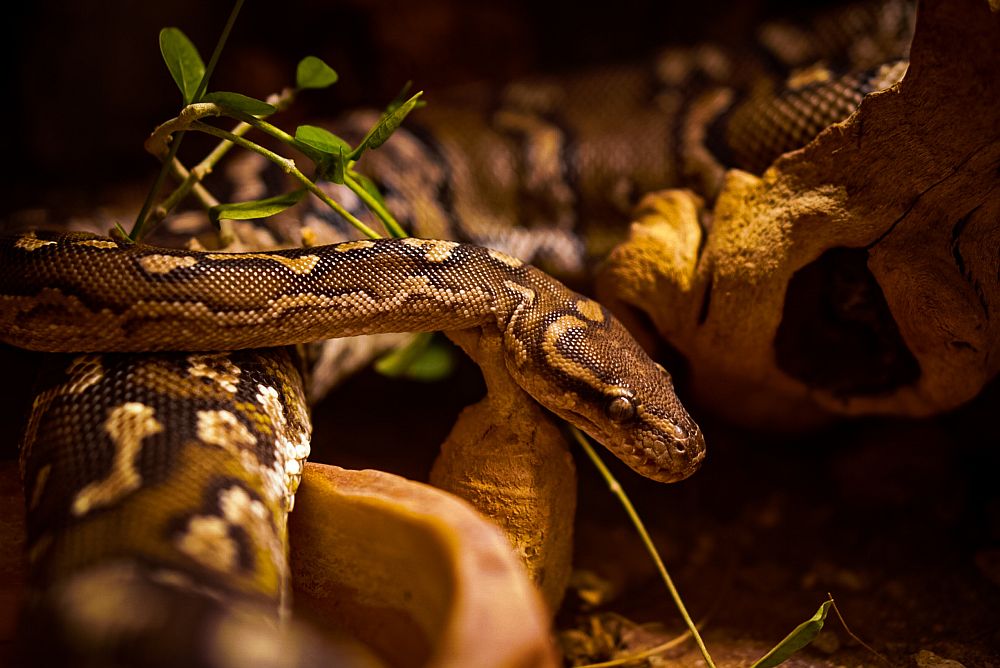
A big Burmese Python is an unforgettable sight. With their enormous girth and mellow disposition, a Burmese Python is about as close as you can get to having a pet dragon.
Baby Burmese Pythons are readily available online, in pet stores, and at reptile shows. But that baby is going to grow very quickly into an enormous and potentially dangerous pet. Burms are no small snake, and keeping them is no small responsibility.

If you’re thinking about adding a Burm to your snake collection, read on.
When you’re done with this article, you will know what it takes to provide good Burmese Python care.
Burmese Pythons are beautiful, docile snakes that eat well and are generally easy to keep. But Burmese Pythons are not a good snake for beginners. Burmese Pythons are giant snakes that require large cages and large food items. And because of their great strength, Burms can be dangerous and even lethal.
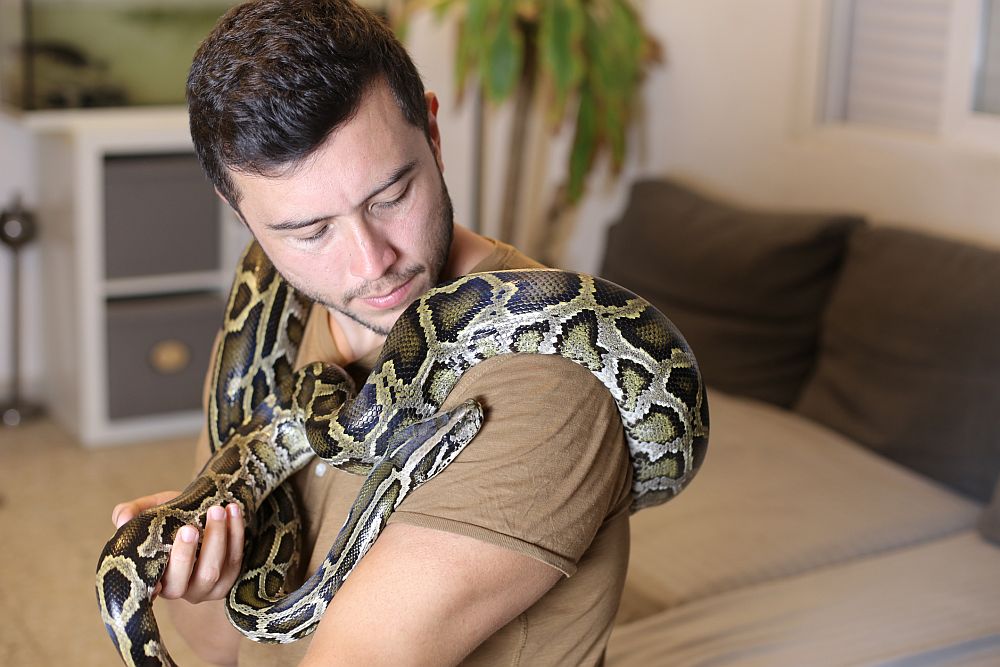
Burmese Pythons can be excellent pets for people who have:
Among the giant constrictors, Burmese Pythons are by far the best pets. They tolerate handling well and are relatively easy to care for if you have the space.
Ideally, you should first get some hands-on experience with a friend’s Burm. But if you have some experience with Boa Constrictors or with large, powerful pets like horses or mastiffs, you should be able to handle a pet Burmese Python.
| SPECIES OVERVIEW | |
| Scientific name | Python bivittatus |
| Common name | Burmese python |
| Family | Pythonidae |
| Size | Up to 19 ft and 400 lbs |
| Life expectancy | 25 years average, up to 30 years |
| Tank size | At least 8 ft x 4 ft x 4 ft Strong, and very secure |
| Humidity | 50 to 70% |
| Temperature | Hot side 89-95F Cool side 75-80F |
| Feeding | Baby: mice or small rats (twice a week) Adult: rats, or rabbits (every two weeks) |
Before you buy a cute little baby Burmese Python, ask yourself if you have the room and resources to house an adult Burm. Some people will tell you that snakes only grow as big as their tank, but that’s not true. Your Burm will grow no matter how big or small the cage.
A proper enclosure is vital to ensuring your Burmese Python’s health and well-being.
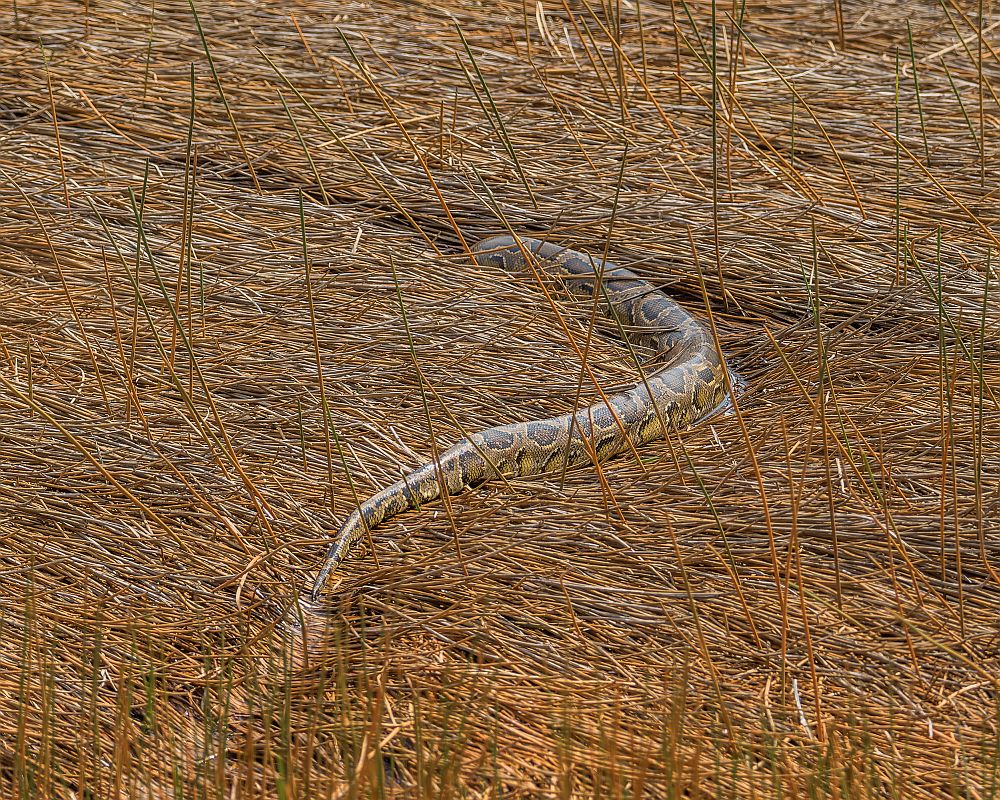
Your baby Burmese Python will fit comfortably in a 20-gallon or 30-gallon tank. But that won’t last long. In the wild, a Burm’s size is its greatest defense and so they have evolved to grow very quickly. Depending on its sex and on how much you feed it, your Burmese Python hatchling will be between 6 and 10 feet (1.8 – 3 meters) by its first birthday.
Most male Burmese Pythons will top out at 8-14 feet (2.4 – 4.2 meters), while adult female Burmese Pythons typically measure between 13-18 feet (4 – 5.4 meters).
A small to medium-sized adult male Burmese Python pet might be comfortable in a 6 x 3 x 2 enclosure. A female will need an 8′ x 3′ x 2′ cage and a big female will do better in a 10′ x 4′ x 3′ or even larger Burmese Python enclosure.
Burms are not climbers, so cage length and width are more important than height. But whatever you choose, your Burmese Python enclosure needs to be sturdy. An adult Burm is incredibly strong and can wedge open a wooden cage if it is not well-constructed.
And if you’re not breeding your Burmese Pythons, you should keep them separated. Burmese Pythons are not social animals and will fight over food and territory.
Because they leave bowel movements befitting their size, you will want a Burmese Python substrate you can change out quickly and cheaply. Many owners say that newspaper is the best Burmese Python substrate, as newsprint is absorbent and easily available.
Other owners prefer a shredded wood substrate for Burmese Pythons, as it is more aesthetically pleasing and easier to spot-clean than newspaper. If you choose shredded wood for your Burmese Python substrate, avoid cedar shavings as they can be toxic to snakes.
Because they come from tropical southeast Asia, Burmese Pythons need a warm enclosure.
Like all reptiles, snakes are cold-blooded and rely on their enclosure’s hot and cool sides to regulate their body temperature.
Your Burmese Python’s hot side should be between 89-95 degrees, and the cool side should be between 75-80 degrees. You can use either a basking light or under tank heating pad. (Some Burmese Python keepers use both).
Because a properly heated enclosure is so important to your Burmese Python’s health, you really shouldn’t guess at the temperatures.
A quality temperature gauge along with a rheostat and timer can ensure your Burmese Python enclosure stays at a proper temperature.
In the wild, Burmese Pythons live in humid swamps, wetlands, and jungles. They will do best in environments with relative humidity between 50% and 70%.
You should make sure that your Burmese Python enclosure has adequate ventilation. If you see droplets forming on the enclosure windows, the humidity is too high and your Burm may be at risk of skin or respiratory infections.
If your humidity is too low, your Burm is at risk for bad sheds and stuck eyecaps.
Baby Burmese Pythons can be started on fuzzy rats, but will soon graduate to bigger prey. A 4-foot Burm will be taking medium rats, and a 6-foot long Burm will be taking large rats.
While a big female will have no trouble taking piglets or young goats, almost every adult Burmese Python pet will be content with a regular diet of chickens or rabbits.
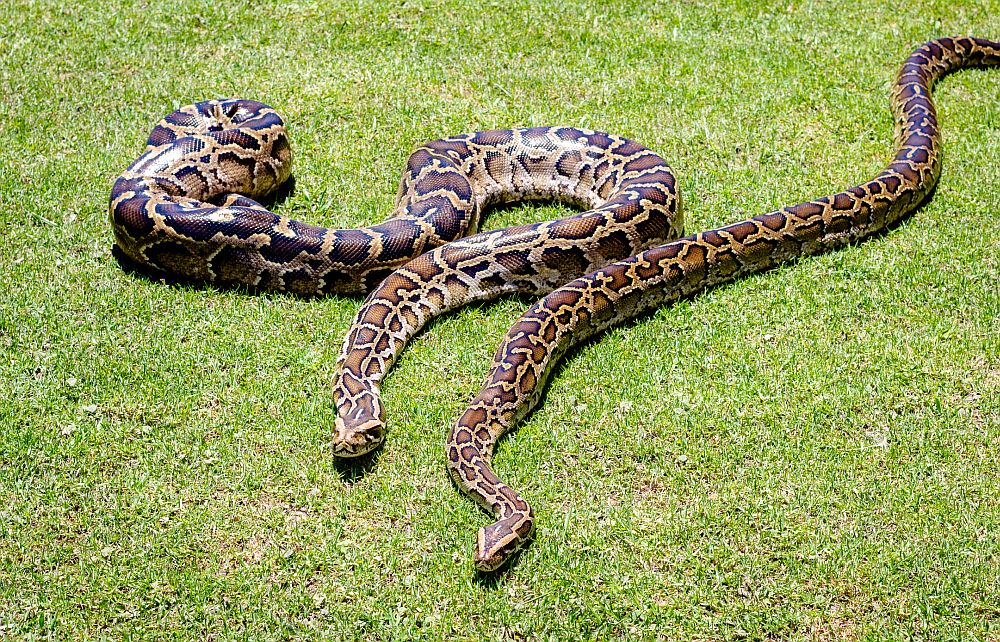
Live prey can come with parasites and diseases and can injure your snake. If possible, you should feed your Burm frozen/thawed food for safety. This should be no problem, as Burms are famous for their healthy appetites and almost all will happily take every frozen/thawed meal you throw their way.
As your Burmese Python gets bigger, you will have to become more conscious of your own safety. Almost all recorded Burmese Python deaths involve a Burm mistaking its keeper for food. In the wild a Burm that misses a meal might not get another chance for weeks. When a Burm thinks food is nearby it strikes immediately.
One of the best ways to make feeding time safer is by using a snake hook. Remove your Burmese Python with a hook, or simply rub its nose gently with the hook, when you are opening the cage for cleaning or anything else that doesn’t involve feeding.
In time the Burm will learn that the snake hook means there is no food coming, and will be less likely to charge to the front in search of a meal every time you open the door.
You should also use tongs whenever you feed your pet Burmese Python. This puts more distance between your body and your striking Burm, and ensures that any missed strike lands on the tongs instead of your forearm.
A 10-foot long Burmese Python should not be handled alone, and a Burm over 15 feet long should be handled by three or more people. If a Burmese Python wraps a coil around you, you could be unconscious in seconds and dead within a minute or two.
While they are generally hardy snakes, there are some Burmese Python health issues that keepers need to watch out for.
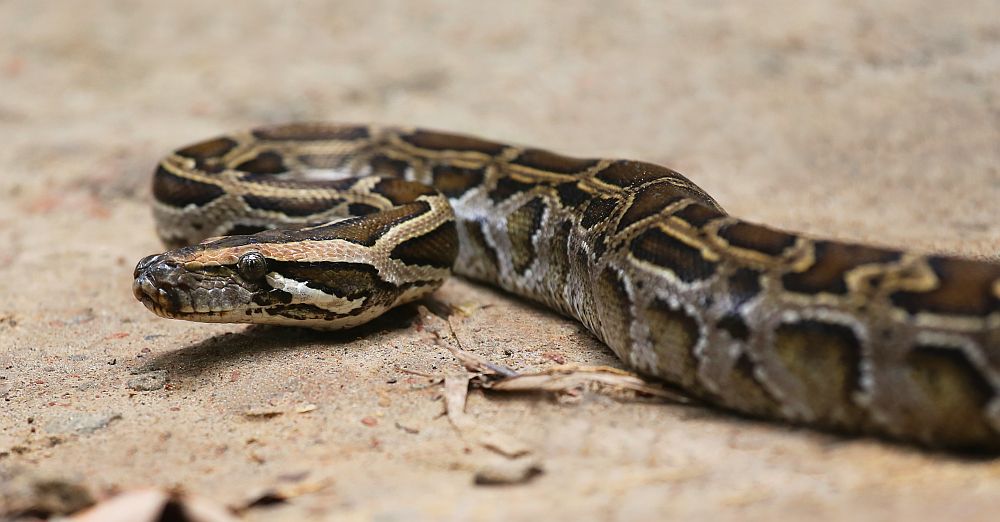
Obesity is a frequent problem with captive Burmese Pythons. In the wild, food is not always available, so a wild Burm will grab a meal whenever it can. That instinct survives in captivity, where food is readily available. While some snakes can be picky eaters (looking at you, Ball Pythons), a Burm will generally take food whenever offered.
Burmese Pythons can be susceptible to scale rot and mouth rot if they are left in unclean conditions. Make sure to change your Burm’s bedding regularly. They’re big snakes and when they go, Burmese Pythons leave big piles and puddles behind. Make sure humidity isn’t too high, and watch out for overturned water dishes.
Excessive humidity or cold habitat temperatures can also lead to respiratory infections in Burmese Pythons. If you see your Burmese Python holding its head up with its mouth gaping open, or if you notice bubbles around its nose, take it to the veterinarian immediately.
Many giant pythons are notoriously nippy. Reticulated and African Rock Pythons are infamous for striking first and asking questions later. Burmese Pythons are famous for their placid, peaceful dispositions. While some Burms can be cage-defensive, most are easy-going snakes that tolerate handling well.
But while Burms are unlikely to strike defensively, they have a very powerful feeding strike. Keepers have died when their Burm mistook them for a meal. Even if you don’t get squeezed in a coil, a Burmese Python bite can send you to the emergency room with deep lacerations.
To avoid tragedies, treat your pet Burmese Python with respect, wash your hands thoroughly before handling, and never leave your Burmese Python out of its habitat unsupervised.
You’ve read through the care requirements and you understand just how big your new pet Burmese Python is likely to get. After due consideration, you’ve decided that you’re ready for the challenge of owning one of these gentle giants.
Burmese Python prices can vary widely depending on a number of factors. Proven breeders will be more expensive than baby Burmese pythons, and private breeders generally charge more than pet stores. Perhaps the biggest factor in the price of a baby Burmese Python is whether it is a regular type or a morph.
While you can sometimes find baby Burmese Pythons in pet stores, you will be much better off purchasing your Burmese Python from a reputable breeder. Pet store snakes are often poorly cared for and come with mites, parasites, or diseases that can result in heartbreak and costly veterinary visits.
A breeder is also more likely to sell accurately sexed baby Burms. Because they are smaller adults, many keepers prefer working with male Burmese Pythons. The difference between a male and female Burmese Python can be as much as seven feet and 100 pounds, so you really want to get this one right.
Reptile Expos are a great place to purchase snakes and to network with reptile enthusiasts who are happy to share care and maintenance tips. If your local reptile exhibition is held in an area where Burms are legal, there will likely be several breeders selling baby Burmese Pythons.
While the wild-type Burmese Python is beautiful, several Burmese Python morphs are available on the market. These morphs are more expensive than normal Burms, and some are considerably more so.
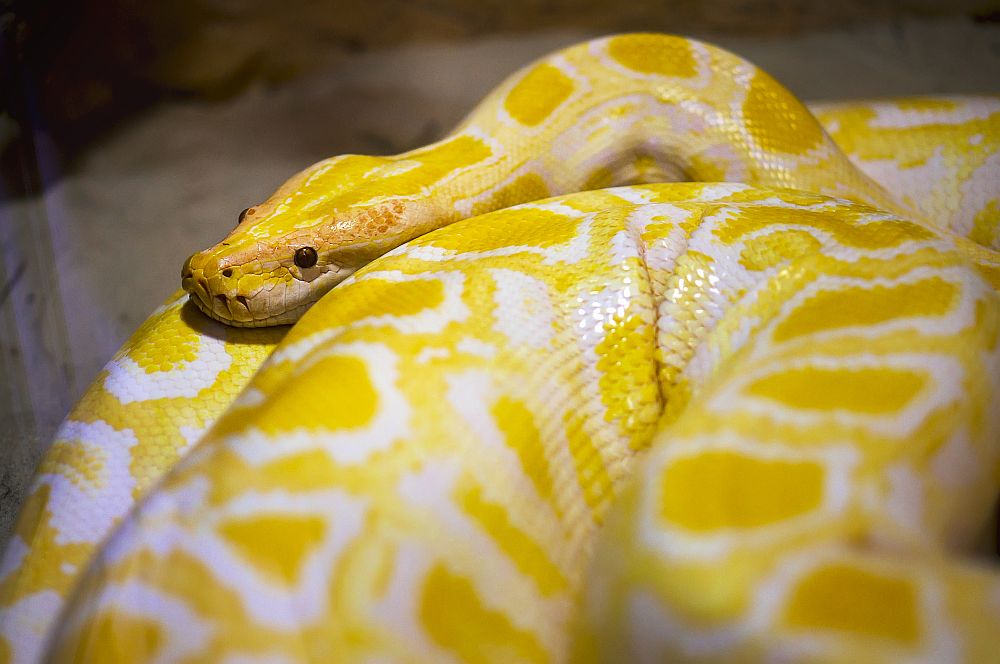
With its ruby-red eyes and bright canary-yellow patterns against a snow-white background, the Albino Burmese Python morph is especially popular.
Albino Burmese Pythons are widely available, and the Albino morph has been mixed with other morphs to produce Albino Labyrinths, Albino Greens, and other combinations.
This morph greatly reduces the Caramel Albino Burmese Python’s production of black pigment but does not influence other pigments. Caramel Albino Burmese Pythons have a beautiful honey color with lavender-tinted tans. This is a newer morph and so Caramel Albino Burms can be quite expensive, especially when combined with other morphs.
Instead of a pattern, Granite Burmese Pythons have dark speckles on a tan background. The Granite Burmese Python morph also removes the typical spear-shaped black head markings, giving Granite Burmese Pythons an adorable pink head.
The Green Burmese Python morph has no pattern and its background color ranges from khaki to dark olive green. The Green Albino Burmese Python looks like a giant banana, and Green Granite Burms are also popular with keepers.
The Labyrinth Burmese Python morph breaks up the wild type’s blotches and transforms them into swirling patterns that resemble a maze or a labyrinth. The Labyrinth morph also lightens the background color from brown to a golden-tan.
The Piebald Burmese Python morph was discovered in a wild-caught Burm and has only recently been proven inheritable. The Piebald Burmese Python’s pattern is interrupted by white blotches on the body. The Piebald Burmese Python is breathtaking in person, and so is its price tag.
Before you buy a baby Burmese Python, check your state and local laws.
Burmese Pythons are illegal in several states (notably Florida), and many cities also have laws prohibiting Burmese Pythons and other giant constrictors.
If you are renting an apartment or are part of a homeowner’s association, you should also make sure that there are no regulations against Burmese Pythons.
Many HOAs treat giant constrictors as dangerous animals like pit bulls.
Burmese Pythons are an invasive species in Florida. These southeast Asian giants have established breeding populations in several southeastern Florida counties, where they compete with native wildlife for birds, deer, and other prey.
Burmese Pythons are the most docile and easy-going of the giant pythons, but they are still giant pythons. Snakes do not bond with their keepers like warm-blooded pets. When they come to the front of their enclosure they aren’t saying hello, they are looking for food.
While baby Albino Burmese Pythons are occasionally born in the wild, most are soon killed since their yellow and white coloration makes them stand out in their environment. Albino Burmese Pythons are preserved in captivity by snake keepers through selective breeding.
No snake is poisonous. Fugu puffers, which can kill you if you eat them, are poisonous. There are some venomous snakes that kill their prey by injecting venom through their fangs. But while a Burmese Python’s bite is painful, it is not venomous. Burms kill their prey with constriction, not venom.
While there are stories of 10-meter long Burmese Pythons, the biggest recorded length for a Burmese Python is 18 ft 10 in (5.74 meters) [1]. “Baby,” the record-setting Burmese Python, weighed 403 pounds (182.8 kg) and was 27 years old at the time of her demise.
Unlike geckos and iguanas, Burmese Pythons do not need UV light to produce vitamin D and metabolize calcium. Hence, UVB lights are not necessary for a Burmese Python enclosure and could even give Albino Burmese Pythons sunburn.
In southeastern Asia, Burmese Pythons often eat deer, monitor lizards, large rodents, and ground-dwelling birds. In Florida, Burmese Pythons have been known to eat opossums, raccoons, rabbits, birds, and even bobcats and alligators.
In the wild snakes time their activities by a day/night cycle, which means your snake needs darkness at night. If your snake’s enclosure has 24 hours of light, your snake could become stressed and may stop eating. A timer on your lights can give your snake the rest it needs.
In addition to Myanmar (formerly Burma), Burmese Pythons are found in a range from eastern India through Vietnam and southern China and on the islands of Java, Bali, and Sulawesi. Escaped or released Burmese Pythons have established populations in southern Florida.
The Reticulated Python regularly reaches lengths of over 20 feet (6.25 meters), making it the world’s longest snake. The world’s heaviest snake is the Green Anaconda, which can reach weights of over 550 pounds (250kg).
Citation
1. Bull. Chicago Herp. Soc. 47(1):1-6, 2012, p.3
http://vpi.com/sites/default/files/Barker-et-al_CorrectPythonLengths_2.pdf
Burmese Pythons are big and beautiful, but they are not for everyone.
If you aren’t up to the responsibility of owning a snake that weighs more than you do, there are many smaller snakes that can provide you with years of snake-keeping joy.
But if you have the room and an assistant or two, you may find the Burmese Python is just the snake you were looking for!
Reptile Advisor is a free resource for reptile owners of all experience levels. We publish weekly informational guides with easy-to-understand graphics to help you in your reptile-keeping journey.

I am obsessed with reptiles and have been keeping them my entire life. Read more about my experience.